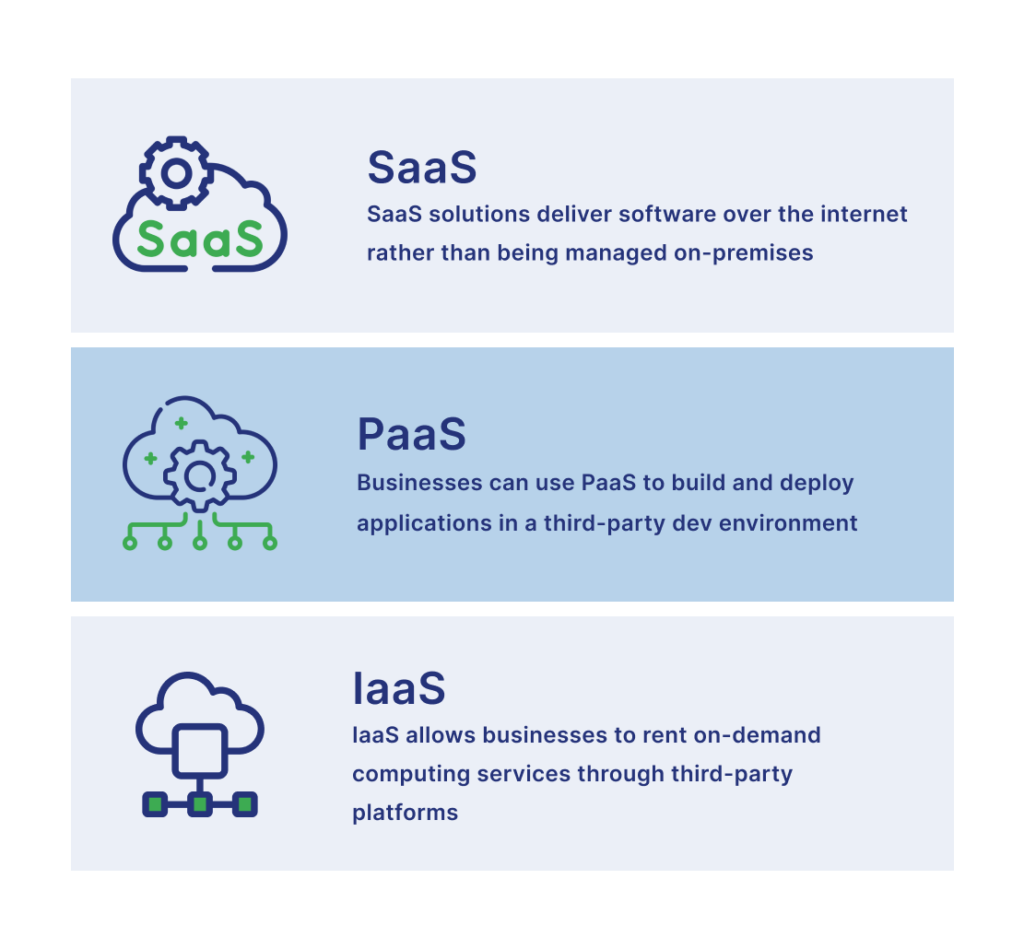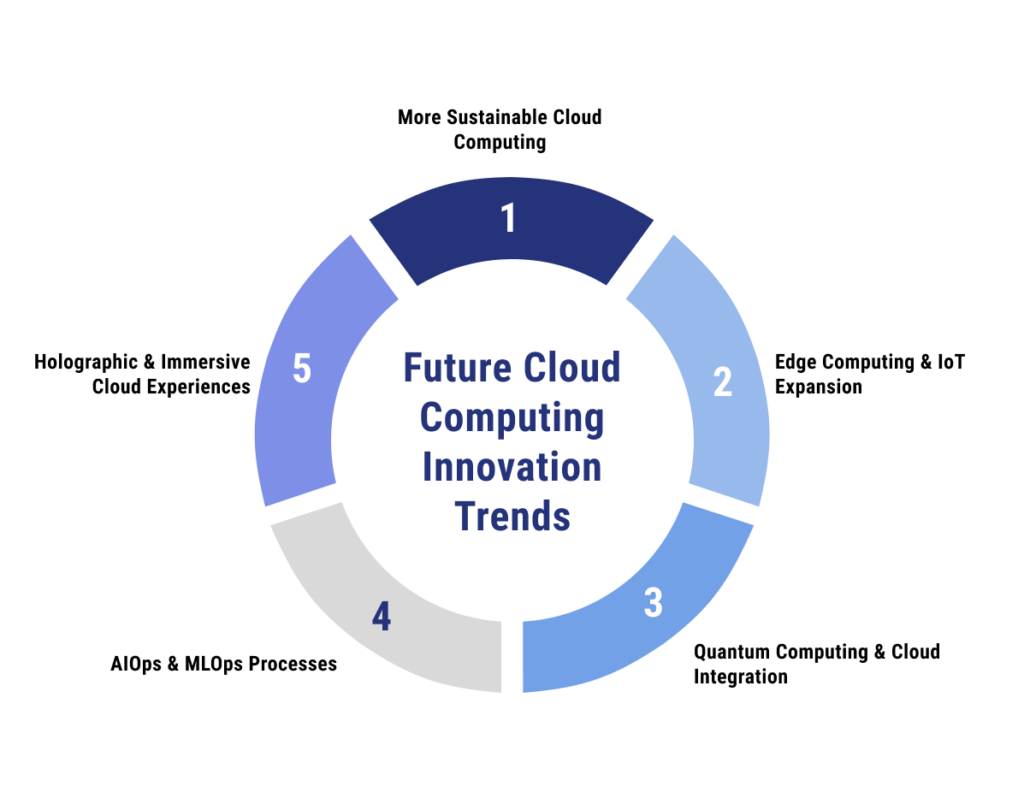
In TierPoint’s 2025 Technology & IT Modernization Report for Mid-Sized Businesses, 99% of the 400+ IT decision-makers surveyed said they had plans to adopt or invest in emerging cloud technologies and strategies for their organizations over the next 12-24 months.
This finding highlights the critical importance of cloud computing innovation for organizations seeking to establish a competitive edge by integrating the most cutting-edge digital technologies into their daily operations.
In this article, you’ll discover:
- How to embrace cloud computing innovation within your organization.
- How past cloud computing innovations have shaped today’s digital landscape
- The technologies laying the foundation for ongoing innovation in the cloud
- The future of cloud innovation
Defining Cloud Computing Innovation
Cloud computing innovation refers to the development or adoption of new and emerging cloud-based technologies, including hardware and software, cloud-based services, and operating models that empower organizations to enhance the capabilities, efficiency, and value of cloud-based services.
Amazon Web Services (AWS), the first major public cloud platform, launched in 2006, followed closely by Google Cloud Platform in 2008 and Microsoft Azure in 2010. With the world’s largest technology companies managing the underlying IT infrastructure, cloud computing innovation has rapidly become one of the most dynamic areas of technological innovation.
In Episode 14 of TierPoint’s Cloud Currents podcast, we asked Mark Angle, Chief Cloud Officer at OneStream Software, how adopting new and emerging cloud computing innovations was helping OneStream achieve its growth targets and delight customers:
“Cloud innovation enables us to serve thousands of enterprise customers, securely and efficiently, with an infrastructure that can scale as fast as they do.”
— Mark Angle, Head of Public Sector at OneStream Software
Now let’s take a look at seven examples of cloud computing innovation that are already helping organizations increase value generation from their cloud investments.
7 Examples of Innovation in Cloud Computing Services
Over the past 25 years, innovations in cloud computing have created new opportunities for organizations to expand their digital operations, increase business efficiency, and generate increased value from their cloud IT investments. To set the stage for the latest cloud developments, we highlight some of the most important cloud innovations in the 2000s.
- SaaS – Software-as-a-Service (SaaS) is a software delivery model where customers access a software application over the internet instead of installing it on local machines. Salesforce CRM, launched in 1999, was one of the first enterprise-grade SaaS applications to achieve mass adoption. It allowed customers to access the CRM through a web browser while Salesforce managed the underlying infrastructure, servers, and databases required to run the service.
- IaaS – Infrastructure-as-a-Service (IaaS) was an early cloud computing innovation that became the primary business model for public cloud providers like AWS, GCP, and Microsoft Azure. In this model, users can rent IT infrastructure (e.g. compute, data storage, networking, etc.) on a pay-per-use basis and avoid the high capital costs of purchasing equipment and setting up an on-prem data center to host business applications. The first major IaaS platform was AWS, which introduced Elastic Compute Cloud (Amazon EC2) in 2006.
- PaaS – Platform-as-a-Service (PaaS) products are cloud-based developer platforms with pre-packaged hardware, software, and services to support cloud-native application development. This cloud computing innovation made it faster and easier for developers to build and deploy applications in the cloud. The first PaaS product was Zimki, a Javascript web-app development platform released in 2006. It would soon be eclipsed by PaaS products like Force.com (released by Salesforce in 2007) and Google App Engine (released by Google in 2011).
- Containerization – Containerization technology is a cloud computing innovation that has made it easier for developers to build applications that are portable across diverse environments. While container technologies existed for years, Docker–released in 2013–was the first platform to make containerization accessible and widely adopted in cloud-native development.
- Container Orchestration – Complex IT environments host hundreds or even thousands of containers that would be extremely time-consuming to manage individually. Container orchestration platforms make it easier for developers to manage containers at scale, facilitating key tasks like scheduling, load balancing, resource scaling, error management, and updates. Released in 2014 and originally developed by Google, Kubernetes is the most popular container orchestration platform.
- IaC – Infrastructure-as-Code (IaC) is a cloud computing innovation that makes it faster and easier to provision cloud infrastructure by allowing developers to manage and provision cloud resources by writing code instead of through a manual interface or configuration tool. AWS released CloudFormation, its first IaC tool, in 2011. Later tools like Terraform brought infrastructure-as-code to a wider, multi-cloud audience.
- Serverless Computing – Serverless computing is a cloud computing model where the cloud provider manages the infrastructure, allowing organizations to build and deploy cloud-based applications without having to provision, scale, or manage the underlying resources. AWS Lambda, Amazon’s public cloud serverless computing service, was released in 2014.

What’s Driving Cloud Computing Innovation in 2025?
The innovations we highlighted above have expanded public access to cloud infrastructure and development platforms at scale. They’ve empowered organizations to adopt new software solutions with less management overhead, build and deploy applications more efficiently, and accelerate digital transformation.
Now let’s consider how these technologies are working alongside new and emerging technological advancements to propel cloud computing innovation in 2025.
Artificial Intelligence and Machine Learning
Artificial intelligence and machine learning (AI/ML) have been around for decades, but recent innovations in high-performance computing, distributed systems, and cloud-based GPU/TPU infrastructure have made it easier for organizations to process massive data sets and train complex models. As a result, AI/ML is more accessible and scalable than ever before.
AI/ML in the cloud allows businesses to quickly extract valuable insights from data, automate processes, and cut down on the time it takes to make important decisions.
DevOps and CI/CD
DevOps practices combine software development and IT operations teams into a single unit to streamline the iterative process of software development and deployment. Continuous integration/continuous delivery (CI/CD) pipelines further accelerate the work of DevOps teams.
Cloud platforms can support DevOps and CI/CD through a wide range of tools and services, unifying efforts, automating repetitive processes, and improving the testing process to propel new features and updates from these teams.
Cloud-Native Technologies
Businesses can leverage cloud-native technologies, such as microservice architecture, serverless computing, and managed services to build and deploy applications with greater speed and efficiency. Because these tools are designed specifically for the cloud, they offer greater scalability, flexibility, and reduced operational overhead compared to non-cloud tools.
Containerization
Containerization platforms and container orchestration services have been around for the past decade, but they remain an important driver of cloud computing innovation in 2025.
Containerization technology allows developers to build applications that are highly scalable and portable between environments by combining application code and all its dependencies into a single lightweight package called a container, while container orchestration services like Kubernetes allow CloudOps teams to manage those containers at scale.
Together, containerization and orchestration make it faster and easier for organizations to develop applications that can run in multiple environments, operate complex IT systems, and drive cloud innovation.
Cloud-Native Security
Cloud-native security is a proactive approach to securing applications and data in cloud environments. One of its foundational principles is zero trust, which establishes a framework where no user or device is inherently trusted, regardless of its location or network connection. This approach involves continuous authentication, authorization, and access control for all users and devices, minimizing the risk of unauthorized access.
By embedding security into the development and deployment processes of cloud-native applications, organizations can ensure that security is a core consideration from the outset. Optimizing cloud-native security helps organizations drive cloud computing innovation while reducing the risk of a data breach.
Multicloud and Hybrid Cloud Management Platforms
Multicloud and hybrid cloud platforms have emerged as powerful solutions for businesses seeking to optimize their IT infrastructure across diverse environments.
Tools like Azure Local (enabled by Azure Arc), AWS Outposts, and Google Anthos address the growing need for flexibility and unified management as IT landscapes continue to become more complex, allowing organizations to seamlessly manage workloads across public clouds, private clouds, and on-premises environments.
The ability to efficiently manage multicloud and hybrid cloud environments through a single pane of glass is making it easier for organizations to build powerful cloud-native solutions that combine best-in-class capabilities of multiple cloud providers in new and innovative ways.
High-Density Colocation
As cloud-native technologies like AI/ML, containerized microservices, and DevOps pipelines push the limits of performance and scalability, high-density colocation is becoming a critical enabler. These environments provide the power and cooling required for next-gen hardware, like GPU clusters and hyper-converged infrastructure, while offering low-latency connectivity to public clouds. For organizations balancing cloud innovation with data gravity, cost predictability, or compliance requirements, high-density colocation offers a strategic foundation for hybrid architectures that fuel agile development and AI-driven insights.
One example here is TierPoint’s partnership with Groq, an AI organization that needed seamless access to high-density compute to power its innovative LPU Inference Engine. Partnering with TierPoint gave Groq access to the ultra high-density colocation services needed to support the most demanding AI workloads, along with seamless scalability and 24/7 monitoring and maintenance.
Emerging Technologies Shaping Cloud Computing
The next generation of cloud computing innovation will redefine the boundaries of what organizations can accomplish in the cloud. Emerging technologies like quantum computing, AR/VR, and AI-driven operations are gaining traction, creating greater demand for high-performance, scalable, and energy-efficient infrastructure.
Let’s take a closer look at some of the emerging technologies that could shape the future of cloud computing innovation over the next decade.
Energy Efficient Cloud Computing Technologies
As high-performance computing places greater demand on energy grids, we should continue to see more initiatives aimed at reducing the environmental impact of the cloud and improving data center sustainability. This may include increased reliance on renewable energy sources, energy-efficient improvements made to hardware and software, and more sustainable data center systems, such as closed-loop liquid cooling.
Edge Computing and IoT Expansion
The growth of Internet of Things (IoT) devices has driven demand for real-time data processing. Smart home devices and personal health monitors, for example, rely on almost instantaneous responses to function at their peak.
Edge computing processes data closer to where it is generated, instead of returning to a centralized cloud location, reducing network latency and improving response times. More devices are currently being developed for which this real-time feedback is critical, including autonomous vehicles and industrial automation.
Quantum Computing and Cloud Integration
Quantum computing has the power to solve complex problems that were previously out of reach for conventional computers. This form of computing may aid in drug discovery, more precise financial modeling, and materials science advancements. Cloud integration may make this form of computing more accessible to a wider audience, opening up the potential for greater innovation on a scale not currently possible.
AIOps and MLOps Processes
Along with the growth of AI/ML is the rise of operations processes, called AIOps and MLOps. These disciplines can automate tasks and improve efficiencies by reducing the reliance on manual tasks in the operation, development, and deployment phases. IT teams that successfully leverage AIOps and MLOps processes could free themselves for more strategic projects.
Holographic and Immersive Cloud Experiences
We have yet to see the full potential of the cloud when it comes to immersive entertainment experiences. Cloud-powered augmented reality (AR) and virtual reality (VR) services could create new paradigms for remote collaboration, education, and entertainment as these services evolve and gain traction.

5 Strategies for Embracing Cloud Computing Innovation
Embracing cloud innovation shouldn’t be taken lightly. Organizations should assess their goals and needs before implementing any new tools, and follow that with a solid implementation strategy. Continuing to measure and optimize in the cloud, encouraging an innovation-driven company culture, and investing in cloud skills will only boost your cloud innovation journey.
Assess Business Goals and Needs
Just because a new cloud technology is available doesn’t mean a business should adopt it. Before jumping into the latest trends, you need to understand your business goals and needs.
- What are the pain points and challenges you want to address?
- Where could your business processes be made more efficient?
- What requirements do you need to maintain around data security and compliance?
By asking these questions first, your business can more effectively evaluate new technologies based on their ability to address your challenges, align with your initiatives, and make measurable improvements.
All new technologies need to be weighed against the pros and cons of implementation. Is the time and effort spent adding the tool and training team members to adapt to new processes worth the benefit you’ll gain from it in cost, performance, security, user-friendliness, and so on?
Create a Detailed Implementation Strategy
Once you’ve decided that a new technology is worth it, it’s time to create a detailed implementation strategy. This should include the specific objectives you are trying to achieve with implementation, deployment phases, resource allocation with personnel and budget, strategies to address potential challenges, and change management procedures to improve adoption rates and mitigate disruptions.
Build an Innovation-Driven Company Culture
Setting the standard for a supportive environment from the beginning will make it easier for innovation to take root and evolve. Team members should be encouraged to stay up-to-date on the latest cloud trends and technologies. Innovation projects can be collaborative efforts that involve group brainstorming and all-hands meetings. The more you encourage a culture of curiosity, the more you’ll get early adopters on your side, pushing more cloud innovation projects forward.
Invest in Cloud Skills
In our 2025 Technology & IT Modernization Report for Mid-Sized Businesses, 47% of our survey respondents identified “Lack of Internal Skills/Talent” as a major obstacle to cloud computing innovation.
Investing in cloud skills can mean investing in internal skill development or augmenting your existing IT team to help fill skills gaps. Consider adding outsourced experts to your infrastructure and operations (I&O) plan for a cost-effective and efficient way to boost organizational cloud skills. Some top skills that tend to be missing internally include cloud migration and modernization, DevOps and automation, cloud architecture and design, and cloud security.
Measure and Optimize Innovation Efforts
Cloud computing innovation isn’t a one-time project. Businesses should regularly evaluate cloud initiatives using predetermined key performance indicators (KPIs). These KPIs can determine whether you’ve achieved the goals you set out to accomplish, including cost savings, performance improvements, and efficiency gains. This can also surface opportunities for further cloud solution optimizations.
“Cloud innovation isn’t a one-time migration — it’s an ongoing evolution. We’re constantly rethinking how our architecture scales, performs, and adapts.”
— Mark Angle, Head of Public Sector at OneStream Software
Accelerate Cloud Computing Innovation with TierPoint
Wherever you are on your cloud journey, TierPoint helps you move faster and smarter. We offer high-density colocation for AI and high-performance workloads and expert IT advisory consulting to guide your strategy. Plus, our fully managed cloud services keep your environment optimized, secure, and scalable.
Whether you’re modernizing legacy systems or building cloud-native apps, we provide the infrastructure, expertise, and support to fuel innovation and drive digital transformation.
Ready to take the next step?
Let’s talk about how you can adopt cutting-edge cloud technologies and get more value from your cloud investments. Book a quick intro call to explore how TierPoint can help you accelerate innovation and reach your IT goals with cloud computing.
Prefer to dive in on your own? Download our Journey to the Cloud eBook to compare leading cloud platforms and discover which one fits your unique business needs.

